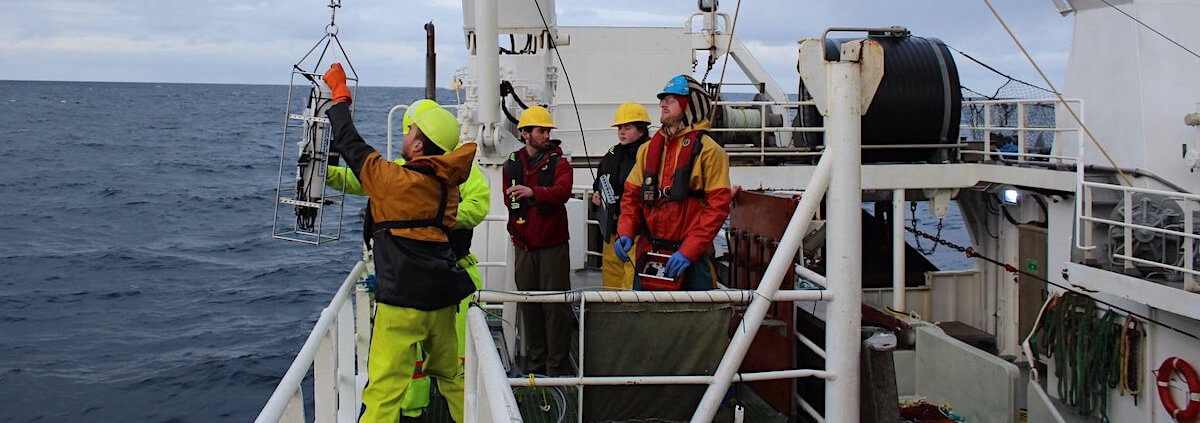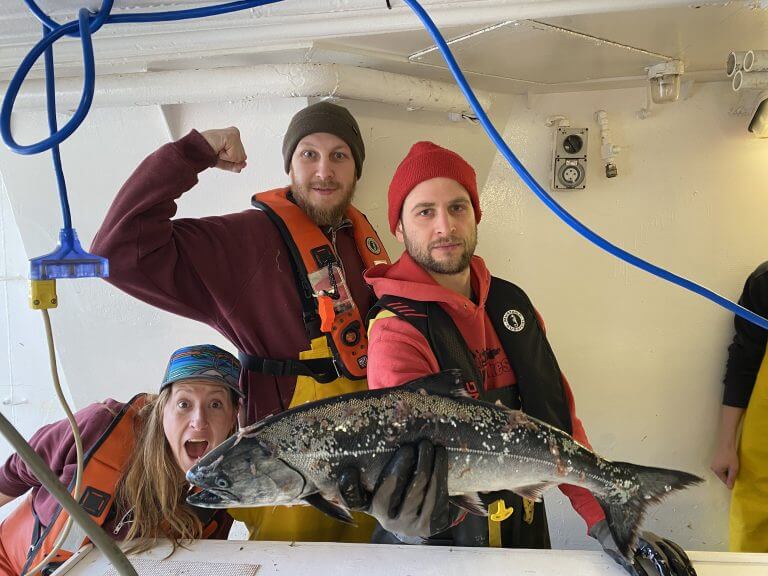Final frontier: Expedition provides data to solve Pacific salmon mystery
This week The International Year of the Salmon (IYS) initiative and the North Pacific Anadromous Fish Commission (NPAFC) announce the launch of two Canadian vessels — the Sir John Franklin and the Raw Spirit — as part of the 2022 IYS Pan-Pacific Winter High Seas Expedition. The researchers are studying topics ranging from environmental DNA to salmon migration patterns to salmon diets. The Pacific Salmon Foundation is proud to have people — Drs. Brian Riddell, Christoph Deeg, and Svetlana Esenkulova — providing valuable research for salmon from this expedition.
“Understanding the impact of climate variation on ocean productivity and salmon production is essential for the future conservation and use of Pacific salmon. Presently, our science is inadequate to provide this forward-looking advice, but this collaboration is an important beginning and provides a basis for future research,” says Dr. Brian Riddell, Scientific Advisor, Pacific Salmon Foundation.
The Canadian fishing vessel the Raw Spirit and the Canadian research vessel the CCGS Sir John Franklin will depart from their respective ports in British Columbia about February 20th to sample the Gulf of Alaska. These vessels will join the NOAA Bell M. Shimada from the United States and the TINRO from Russia, each sampling different zones of the North Pacific Ocean in a major international effort to study Pacific salmon and their ecosystems. The 2022 IYS Expedition builds off successful international voyages into the Gulf of Alaska in 2019 and 2020, as well as the 2021 Russian expeditions in the Western Pacific Winter Expedition.
Riddell and Dr. Richard Beamish (Scientist Emeritus, Fisheries and Oceans Canada) envisioned and organized the 2019 and 2020 expeditions and developed the 2022 expeditions to examine the effectiveness of trawl nets to study Pacific salmon and to continue studies of their winter ecology in the Gulf of Alaska.
“I am excited that two Canadian vessels are departing to join Russian and American vessels now at sea. Canada is to be commended for providing strong leadership and substantial resources to this expedition that will transform the way we study salmon and the North Pacific Ocean,” says Mark Saunders, Director, International Year of the Salmon.
The International Year of the Salmon website has a live vessel tracking map (click here) where you can follow the journey of each ship.
The CCGS Sir John Franklin
The CCGS Sir John Franklin, led by Dr. Jackie King, will include a team of Canadian scientists from Fisheries and Oceans Canada, the University of Victoria, and the University of British Columbia. They will be deploying a trawl net to sample the upper 50 meters of the ocean and will deploy oceanographic gear and plankton nets to sample environmental conditions and the food web that salmon depend on. There are nine postdoctoral fellows and graduate students that will be using data collected by the CCGS Sir John Franklin, and other vessels participating in the 2022 IYS Expedition, to understand salmon and their ecosystems.
The Raw Spirit
The Raw Spirit, led by Chrys Neville, will include Canadian scientists from industry and NGOs as well as two Russian scientists. They will conduct fishing operations in the same region as the CCGS Sir John Franklin but will deploy Japanese gillnets and longlines. Gillnets are fished at night and have the ability to catch a variety of species, including larger fish that may avoid trawls and salmon predators. Using two gear types, the Raw Spirit will provide catch comparisons with the Sir John Franklin trawl catches. The use of longlines will also provide a comparison with Canadian research from the 1960s, which used longlines to tag salmon. Combined with information from the surveys in 2019 and 2020, these results are expected to help explain the reasons for the recent low returns of salmon to British Columbia.
People researching for salmon
The overall findings from the two Canadian vessels will be combined with the findings from the NOAA Bell M. Shimada and the TINRO to understand the current distribution, abundance, and health of Pacific salmon and their environmental conditions following the recent years of extreme climate variability in the North Pacific Ocean.
Deeg, a post-doctoral fellow from the University of British Columbia and a researcher with the Pacific Salmon Foundation, is the only person among the 60 scientists and crew on the five vessels to be aboard two different ships—the U.S.-based Shimada and Canada’s Sir John Franklin.
His work focuses on the connection between climate-change induced environmental conditions and disease in salmon. Deeg’s current study follows-up on research he conducted in 2019 and 2020 in earlier IYS expeditions. He has two peer-reviewed research papers with the findings pending publication in February 2022.
Esenkulova, a researcher with PSF’s Marine Science Program, studies algal bloom and its harmful affects on salmon. She, like Deeg, also conducted research from the 2019 and 2020 IYS expeditions.
Funding the Canadian expedition
This cooperative study led by Canadian scientists will provide the first comparison of ocean research gillnets with trawl nets in the deep-water ocean environment. Drs. Beamish and Riddell have raised funds from government, NGOs and the private sector to charter the Canadian fishing vessel the Raw Spirit. The Great Pacific Foundation is the major private-sector donor, and Parkland fuels is another donor—contributing 100,000 litres of fuel valued at approximately $150,000.
Overall funding for the expedition
The 2022 IYS Pan-Pacific Winter High Seas Expedition is made possible by in-kind ship time contributions from Canada and the United States, and additional financial and technical contributions from Fisheries and Oceans Canada, the British Columbia Salmon Restoration and Innovation Fund (Fisheries and Oceans Canada and the Province of British Columbia), the National Oceanic and Atmospheric Administration, the North Pacific Research Board, the Great Pacific Foundation, the Pacific Salmon Foundation, the Russian Federal Research Institute of Fisheries and Oceanography, the Japan Fisheries Research and Education Agency, the North Pacific Anadromous Fish Commission, the North Pacific Fisheries Commission, the Parkland Fuel Corporation, the Alaska Department of Fish and Game, the Washington Department of Fish and Wildlife, the Tula Foundation, the University of Alaska Fairbanks, the University of British Columbia, Oregon State University, and the University of Washington.
While the vessels are at sea you can follow their progress on the IYS Website and on all IYS online media platforms (Twitter, Instagram, Facebook).
About International Year of the Salmon
The IYS is a five-year initiative (2018–2022) to establish conditions for the resilience of salmon and people in a changing world. It is a hemispheric partnership led by the North Pacific Anadromous Fish Commission in the North Pacific, the North Atlantic Salmon Conservation Organization in the North Atlantic, as well as by NGOs, the private sector, governments, and academic organizations.
About NPAFC
The NPAFC is an international organization that promotes the conservation of salmon (chum, coho, pink, sockeye, Chinook, and cherry salmon) and steelhead trout in the North Pacific and its adjacent seas and serves as a venue for cooperation in and coordination of scientific research and enforcement activities. The NPAFC Convention Area is located in international waters north of 33°N latitude in the North Pacific, Bering Sea and the Sea of Okhotsk beyond the 200-mile zones of coastal States. NPAFC member countries include Canada, Japan, the Republic of Korea, the Russian Federation, and the United States of America.






